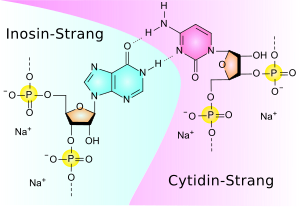Poly I: C
| Structural formula | |||||||||
|---|---|---|---|---|---|---|---|---|---|

|
|||||||||
| General | |||||||||
| Surname | Poly I: C | ||||||||
| other names |
|
||||||||
| CAS number | 24939-03-5 | ||||||||
| PubChem | 32744 | ||||||||
| ATC code | |||||||||
| properties | |||||||||
| Physical state |
firmly |
||||||||
| safety instructions | |||||||||
|
|||||||||
| Toxicological data | |||||||||
| As far as possible and customary, SI units are used. Unless otherwise noted, the data given apply to standard conditions . | |||||||||
Poly I: C is a polymer and analog of double stranded RNA .
properties
Poly I: C consists of two polymeric strands between 1.5 and 8 kb in length , a poly- inosinic acid and a poly- cytidic acid strand, which bond to one another via hydrogen bonds and form a double strand . Poly I: C binds to the toll-like receptor TLR 3 in animals and activates it, which in turn activates the innate immune response . TLR 3 is produced by B cells , macrophages and dendritic cells . The ATC code of poly I: C is L03AX07. As a result of the activation of the TLR 3 by poly I: C, type I interferons are formed. Presumably Poly I: C binds to another receptor. Poly I: C has been studied as an adjuvant in vaccines and to induce apoptosis in cancer cells . An alternative agonist of TLR 3 is RGC100 , a poly- guanylic acid : poly- cytidic acid double strand with lower toxicity and about 100 base pairs in length, since TLR 3 only binds the repeating ribose units independently of the sequence and activation occurs from around 45 base pairs .
Individual evidence
- ↑ Data sheet Polyinosinic – polycytidylic acid potassium salt from Sigma-Aldrich , accessed on July 15, 2020 ( PDF ).
- ↑ a b A. A. Smorodintsev, OA Aksenov, IK Konstantinova, LM Vil'ner, AV Tinufanov: [Comparative study of the toxicity of poly G poly C and poly I-poly C in different objects]. In: Voprosy virusologii. Number 2, 1978 Mar-Apr, pp. 201-206, PMID 664621 .
- ↑ H. Kato, O. Takeuchi, E. Mikamo-Satoh, R. Hirai, T. Kawai, K. Matsushita, A. Hiiragi, TS Dermody, T. Fujita, S. Akira: Length-dependent recognition of double-stranded ribonucleic acids by retinoic acid-inducible gene-I and melanoma differentiation-associated gene 5. In: The Journal of Experimental Medicine. Volume 205, number 7, July 2008, pp. 1601–1610, doi : 10.1084 / jem.20080091 , PMID 18591409 , PMC 2442638 (free full text).
- Jump up ↑ Y. Li, XL Xu, D. Zhao, LN Pan, CW Huang, LJ Guo, Q. Lu, J. Wang: TLR3 ligand Poly IC Attenuates Reactive Astrogliosis and Improves Recovery of Rats after Focal Cerebral Ischemia. In: CNS Neuroscience & Therapeutics. Volume 21, number 11, November 2015, pp. 905-913, doi : 10.1111 / cns.12469 , PMID 26494128 , PMC 4638223 (free full text).
- ↑ WHO : L03 AX07
- ↑ a b I. Yoshida, M. Azuma: An alternative receptor to poly I: C on cell surfaces for interferon induction. In: Microbiology and Immunology. Volume 57, number 5, May 2013, pp. 329-333, doi : 10.1111 / 1348-0421.12050 , PMID 23668603 .
- ^ KA Martins, S. Bavari, AM Salazar: Vaccine adjuvant uses of poly-IC and derivatives. In: Expert Review of Vaccines. Volume 14, number 3, March 2015, pp. 447-459, doi : 10.1586 / 14760584.2015.966085 , PMID 25308798 .
- ^ F. Bianchi, S. Pretto, E. Tagliabue, A. Balsari, L. Sfondrini: Exploiting poly (I: C) to induce cancer cell apoptosis. In: Cancer Biology & Therapy. Volume 18, number 10, October 2017, pp. 747-756, doi : 10.1080 / 15384047.2017.1373220 , PMID 28881163 , PMC 5678690 (free full text).
- ↑ K. Naumann, R. Wehner, A. Schwarze, C. Petzold, M. Schmitz, J. Rohayem: Activation of dendritic cells by the novel Toll-like receptor 3 agonist RGC100. In: Clinical & Developmental Immunology. Volume 2013, 2013, p. 283649, doi : 10.1155 / 2013/283649 , PMID 24454470 , PMC 3878805 (free full text).